The Notre Dame offense came to life against a terrible North Carolina defense in Chapel Hill, and the defense shut down the 15th ranked offense in F+ for a large middle stretch of the game, allowing the Irish to pull away from the Heels. Drew Pyne found his rhythm, the rushing attack gashed UNC, and Notre Dame found both explosive plays and terrific efficiency, avoiding 3rd and longs and creating scoring opportunities on nearly every drive. Defensively, the Irish settled in after some early adjustments and were spectacular for the middle portions of the game before giving up some big plays over the top late in the second half. This was Al Golden on Chopped, easily advancing through the appetizer round, crushing the entree, and then bungling dessert to leave a bad taste in the judges mouths.
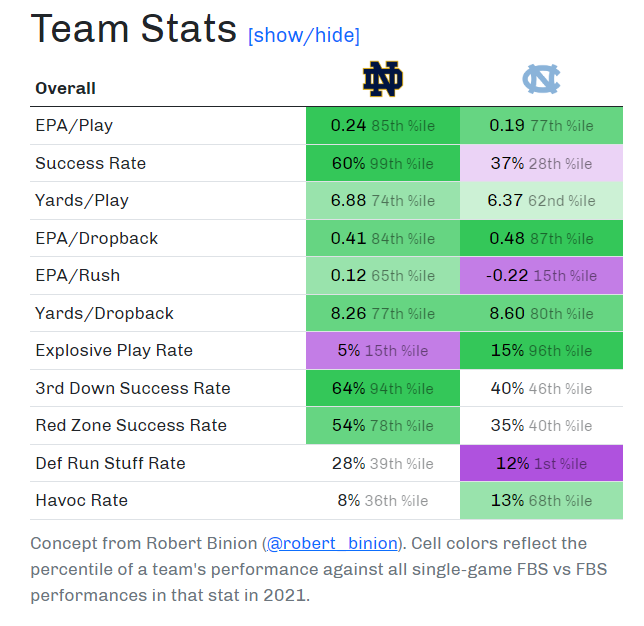
For the first time in 2022, garbage time was a factor. SP+ defines garbage time as >22 points in the 4th quarter, and Notre Dame grabbed a 45-20 lead with 13 minutes remaining. The Tar Heels clawed back with some help from the Irish defense, but we’re throwing out the remaining time (when UNC essentially only passed and ND threw just once) as garbage from the numbers below (13% of overall plays). Both offenses averaged over seven yards per play in garbage time, but Carolina outscored the Irish 13-0.
Stats from a few excellent sources – College Football Data, Game On Paper, and often referencing SP+ and FEI numbers. If you get lost, check out this handy advanced stats glossary here or reach out in the comments.
Flexing on a bad defense still matters
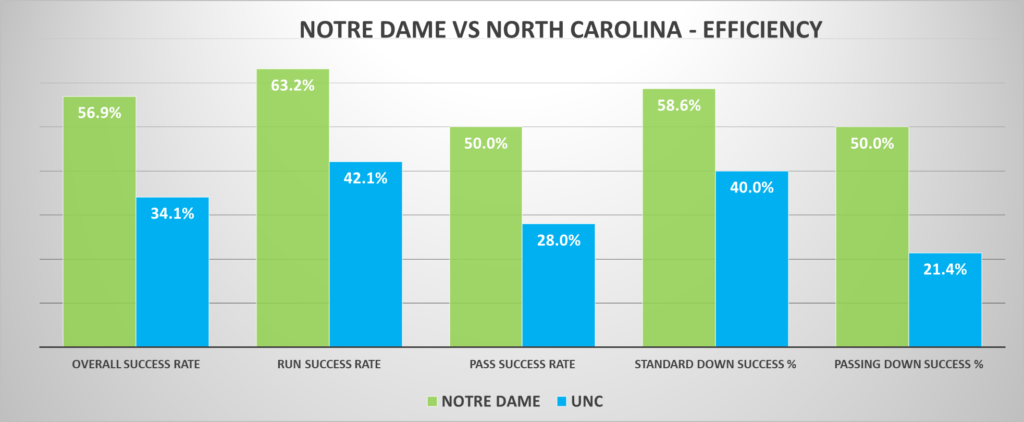
North Carolina’s defense is truly terrible. Every season I deep dive into the Tar Heels projections and look at the defensive talent and think “Well, it can’t get any worse.” And then somehow it is, like the mirror image of Iowa’s offenses.
With that context, it’s tempting to leap ahead and pump the brakes on this offensive breakthrough for Drew Pyne and Notre Dame. But it’s a terrific sign that the Irish could do what was expected (and then some) against UNC’s defense, without even accounting for the experience and confidence gained by young starters.
Last week the top concerns for the Irish offense were the inability to create explosive plays and the struggles on passing downs. Notre Dame nearly doubled its explosive (16+ yard) plays, piling 12 on Gene Chizik’s defense after creating only 15 through the first three games combined. The passing down performance was world’s better (success on 8 of 15 plays), mostly from just avoiding unfavorable situations altogether. Pyne faced just one 3rd down with more than seven yards to gain all game and converted 5/6 on 3rd and medium (5-7 yards). Tommy Rees continues to lean on the short passing game right at or in front of the chains in these situations, but with Pyne gaining confidence maybe the playbook gets expanded over the bye and comings weeks.
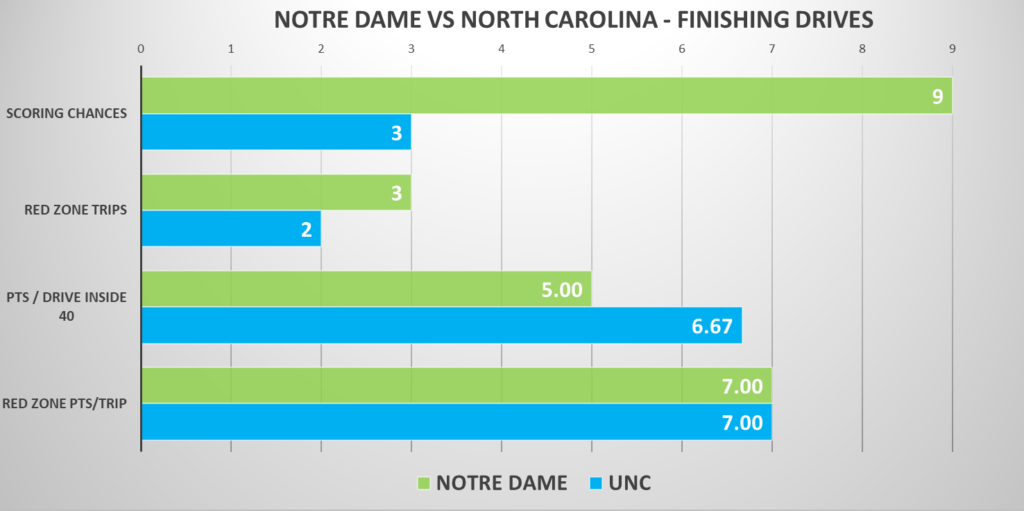
There’s a reason that projection systems reward dominance regardless of the opponent, and Notre Dame moved the ball at will in Chapel Hill. After the initial 3-and-out, the Irish converted each of the next 9 possessions into scoring chances en route to 45 points. With a few opportunities that came up empty – Grupe’s missed field goal, the failed 4th down attempt, Estime’s goal line fumble – close to 60 points was well within reach.
Despite the late scores, a terrific day for the defense
In addition to the efficiency gap, another simple way to visualize the scale of Notre Dame’s control of this game is by looking at FEI’s “Available Yards”. On every possession, the maximum available yards is scoring a touchdown, so from wherever it starts to the end zone. Of those available yards to gain, what percentage does each team grab throughout the game?
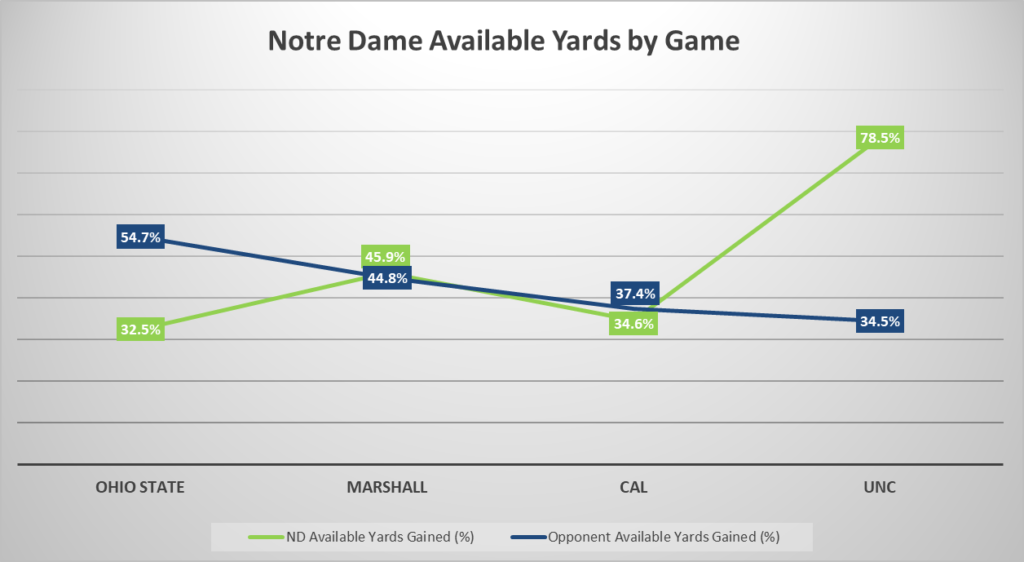
Not only was it by far Notre Dame’s best offensive effort of the season, but also the best defensive game by this metric. Phil Longo’s Carolina offenses have been very good throughout the Mack Brown era, and the 34.5% of yards available gained was the lowest for the Tar Heels since the last time the Irish visited in late 2020!
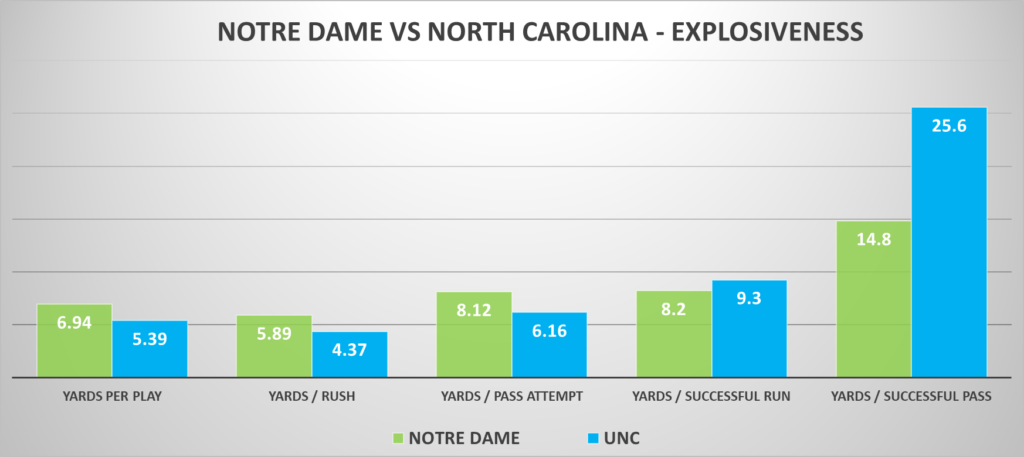
It would have been nice to tie a bow on this performance with a blow-out final score, but the defensive effort before garbage time was terrific. After the initial Carolina scoring drive, the Irish made UNC totally dependent on explosive plays to create offense. For the second straight week, and against a different scheme, the opponent’s running backs were held in check. Drake Maye found some initial success on the ground and was quickly limited. If not for the late coverage busts, I’d argue given the degree of difficulty that it was a more impressive performance by Al Golden’s unit than the offense.
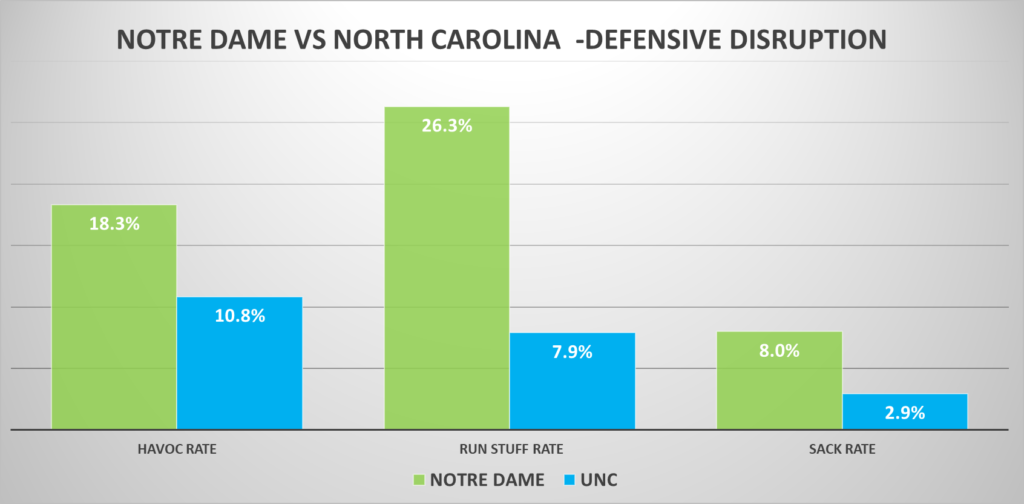
Over the last few games, the Irish have slowly amped up the defensive havoc and pressure. The long turnover drought finally ended with a JD Bertrand strip and Justin Ademilola’s recovery. The interception luck remains bad for Notre Dame, but at 128th in FBS in pass break-ups per game (2 per contest) they’d only be expected to have two at this point.
4 games down, but still so early
College football analytics are terrific but insane, because with the short seasons and lack of overall connectivity in the FBS universe, by the time we have teams almost figured out the season is almost over. So we find ourselves a third of the way through the regular season, yet still mostly in the dark on what this Notre Dame team is and will become. Predictive rankings like SP+ or FEI that factor in preseason projections for accuracy still like the Irish as a top-15 to 25 team. But if you look at any descriptive statistics (like all the accounts I follow that do the graphs with team logos plotted with EPA) you’ll usually find Marcus Freeman’s group in the bad quadrant (or maybe more towards the middle if opponent-adjusted).
The good news is that 2-2 feels 2,000 times better than 1-3. There were moments in the opening stretch where a bowl appearance felt optimistic. The game against North Carolina reminded Irish fans of this team’s upside – a defense capable of shutting down a dangerous QB and offense for quarters at a time, an offensive line that can maul overwhelmed opponents, and a QB that can make the throws needed to move the chains and capitalize on opponent mistakes. How does that translate against competent defenses? We’ll find out after the bye.


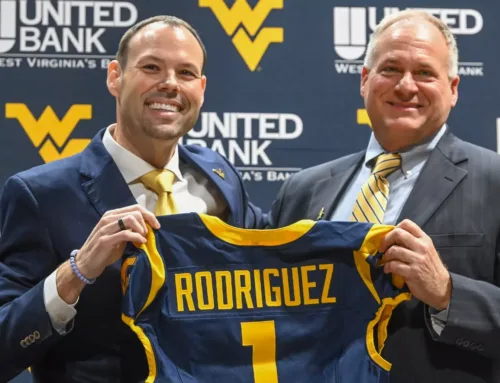
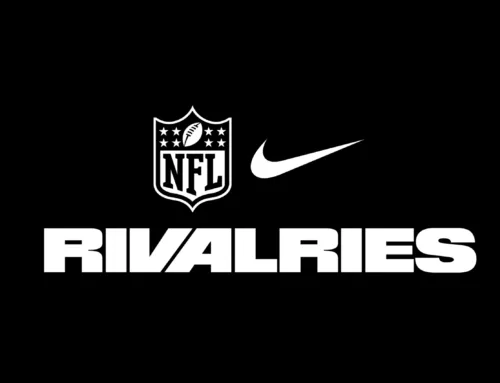
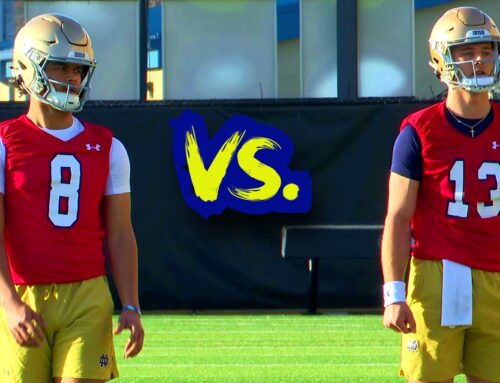
Since no one else has commented, let me just throw out a message of appreciation for all that you writers do for us and for the site. You guys are worth every penny of my subscription, and a big reason why I’m upgrading to premium this year.
Grateful to you guys for my weekly (daily?) fix of bear maulings, classic youtube movie clips, and fullbacks.
We appreciate that, and let me extend a free year’s subscription to you.
Amen. Thank you, team, for continually giving us this stuff. Some folks are addicted to checking Insta; I’m addicted to reading 18S articles.
I was loving this article and all of its seeming optimism. Then this beauty “But if you look at any descriptive statistics (like all the accounts I follow that do the graphs with team logos plotted with EPA) you’ll usually find Marcus Freeman’s group in the bad quadrant (or maybe more towards the middle if opponent-adjusted)”
Puke. lol
I prefer to stay positive. We already beat BYE, how hard can it be to beat BYU?